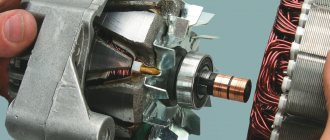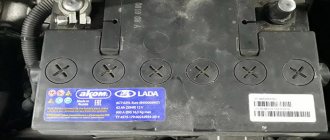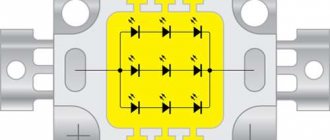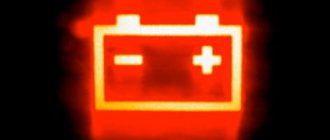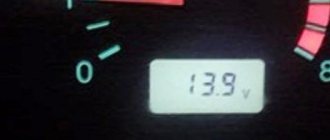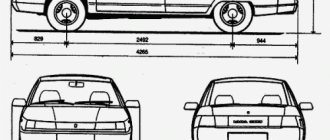Problems with the power supply in a car are major troubles for the car owner. And if these problems began to occur suddenly and in the most unpleasant conditions, you need to know the main reasons for such a problem. Most often, the problem of low voltage in the on-board network is not fatal, but it has its unpleasant consequences. So you should always draw conclusions in a timely manner and reduce the risk of final equipment failure. Poor operation of the main electrical network devices creates many malfunctions and problems. It is very important not to continue using the car with such problems, otherwise you may be left without a car altogether. It is worth recognizing that the danger lies not only in poorly lit light bulbs, but also in a possible short circuit, in a variety of problems and malfunctions of any part of the car.
In a modern car, literally everything depends on electricity, so a poor power supply will be an extremely dangerous factor. It is important to consider that all functions of the machine are connected to electricity. Previously, this resource was needed for launch, and even then it was not necessary. It was possible to start the car from a pusher. Today, without power, it is impossible to turn the steering wheel, open the stack, or even open the car itself. So let's take a closer look at how to diagnose low voltage in the on-board network, determine its cause, and also cope with all sorts of problems in this industry. If you have ever encountered such problems, be sure to describe your case in the comments. Each car may have its own individual problems, but we will consider only the most common problems with your vehicle.
How to identify electrical problems in a car?
The first step is to understand whether your car really has power problems. There are two groups of problems in this regard; roughly, all problems can be divided into problems during startup and strange operation of the electrical network after starting the engine. It is important to distinguish this because different modules are involved in these processes. It’s worth figuring out what symptoms of the car you should look for if the electrical network is not working well after starting the engine:
- the operation of all the lamps in the cabin, as well as the headlights, side lights and brake lights is too dim; this may not be very noticeable, but in reality the difference in brightness is noticeable;
- turning off some elements of the electrical network without permission under fairly heavy loads, for example, when the fan in the cabin is turned on, the music may turn off;
- when revving up at idle, the brightness of the interior lighting noticeably increases for a second, but when other equipment is turned on, the brightness decreases;
- perhaps a barely noticeable or annoying blinking of the light, uneven illumination of the road, rapid failure of light bulbs in various modules of your car;
- a decrease in fan speed is noticeably felt when optics, music or other power consumers are turned on; there may be an incorrect connection in the network.
The problem is that a car owner can easily get used to many such manifestations. And in this case there will be no surprises. You can get used to dim light, poor airflow and other troubles. But in general, this mode of operation is very harmful to your car. Sudden failure of the fuel pump, climate system, poor operation of the automatic transmission and other components is possible.
Troubleshooting
Repair of the Niva Chevrolet generator may be necessary only in some cases when replacing parts does not solve the problem. There are several signs after which it is worth checking the serviceability of the generator assembly. They are as follows:
- After starting the engine, the indicator light indicating the battery should go out. If after the engine starts running the signal still works, then the battery is not being charged, the generator voltage is not enough to charge.
- When the engine was turned on, the headlights became dim. Although there is a charge from the battery, it is too small to support the normal operation of electronic devices in the car; measuring instruments show low voltage characteristics - 12 V.
- There is noise from the motor side, in addition, points 1 and 2 are observed. The sounds may resemble metallic surfaces colliding or whistling. Most likely, the bearing has broken and needs to be replaced.
These 3 signs will help identify, but not recognize, the problem. Without special devices, it is very difficult to guess which part is damaged. Only service diagnostics can give a clear idea of the breakdown.
The diagram and design of the generator, of course, will help in finding a breakdown, but if a person has not previously made such repairs on his own, it is better to take the car to a service center.
The generator and its environment are sources of electricity sags
Network sags are often associated with the generator and its operation. Theoretically, after turning on the power unit, the battery goes to rest and is even recharged from the generator. All tasks for providing power supply are taken over by this small device. There are a certain number of problems that should always be taken into account when you have such problems. The issue of a non-working generator can be resolved by troubleshooting the following problems:
- alternator brushes have to be changed quite often on domestic cars (the element is popularly called a “chocolate bar”), but on high-quality cars they rarely fail;
- Often the cause of problems is the generator relay, which does not produce the required voltage due to internal failures; it can simply be replaced for normal operation;
- problems also arise with the diode bridge; due to the breakdown of one of the diodes, the voltage in the network may fluctuate or be constantly at a very low level, this should be eliminated;
- a problem with malfunctions of the physical part of the generator is less often the cause, but it is also worth checking; it is quite possible that we are talking about the necessary replacement of the shaft and bearings;
- mass and quality of wires to the main modules - an extremely tricky problem is the lack of a good mass; just tug and clean the contacts to solve the problem.
But this is just a suggested list of problems with the generator. The consequence of this problem will be a constantly loaded battery. Also, if there is no current of 14.1 Volts from the generator, the battery will not be able to charge. Therefore, you should measure all voltages in the network using a conventional tester to find out the real state of affairs. Even in the most expensive and elite car, such a breakdown can drive the owner crazy with various manifestations of problems.
Generator
The Chevrolet Niva generator unit allows you to provide the entire vehicle with energy for the operation of all electronic devices of the vehicle. This node consists of 3 main elements:
- generator set - creates alternating current;
- rectifier - converts alternating current into direct current;
- voltage regulator - stabilizes the output voltage.
The total power of the installation of 5000 rpm allows you to maintain a constant voltage of 13-14 V, while the current is 55-60 A. These characteristics are optimal for the normal operating condition of the car. The electricity generated by the generator is distributed to all consumers of the system, and the rest is used to recharge the battery while the engine is running. The generator itself is located near the engine and connected to its crankshaft via a belt drive. Its lower part is attached with 2 special claws to the engine bracket with 1 bolt fastener. The device is secured to a bar at the top via a pin. Since the unit in the VAZ 2123 is located very close to the car engine, it has a reliable design that can withstand loads from vibration, temperature, as well as a humid environment and dirt. A generator rarely breaks down, but some of its parts become unusable after a certain period of use, for example, brushes.
Wires, non-original connections, low-quality devices
The issue of poor-quality connection of on-board network consumers is worth considering in more detail. If you installed the radio in your car yourself, taking power from the wrong place, the problem of battery drain and load on all vital organs will be very relevant. It is better to exclude handicraft interference in the electrical power system altogether. If something needs to be delivered, contact the station and do it efficiently. The following problems of increased load on the system are possible:
- one of the consumers draws all the voltage, reducing it in the network to incredible levels, this could be a subwoofer or powerful speakers that are not provided in the car;
- you additionally installed powerful equipment and connected it through the cigarette lighter and other elements of the electrical network that are not intended for this;
- low-quality wires were used in the connection, also the problem with the wires may be present in the car from the factory, this can only be eliminated by replacing the wiring with a more expensive one;
- a failure in one of the important elements of the electrical network, the presence of increased electricity consumption and a significant drain on the machine’s resources, which negatively affects the network;
- problems with incorrectly installed relays and fuses that interfere with the normal functioning of the car’s organs, but this can only be determined after professional diagnostics.
In fact, all such details are examined only at a professional station, otherwise it will be impossible to get an answer to the question. If you are familiar with electricity, then with the help of a tester you can determine for yourself exactly where the drawdown is occurring. After this, through trial and error, you can find the element that is responsible for the drawdown. But keep in mind that experiments in this area may not end well for your car.
Reason #9. Insufficient cross-section of wires in the battery charging circuit
Occurs after serious and inept repair of car wiring. Insufficient cross-section of wires in the generator-battery circuit is a guarantee of low voltage on the on-board network. In addition, even “native” power wires can have a small cross-section. Over time, the veins gradually break at the bends and at the attachment points, as a result of which the resistance of the chain section increases. Repairing both the first and the second is elementary.
Power loss in the battery - main indicators and causes
We have already talked about the reasons for a dead battery today. This is a poorly functioning generator that does not charge the battery. It is also worth paying attention to the age of the battery in the car. Often the time just comes for her. You can also notice that constant loads in the network can involve the battery, which will certainly drain it. When operating a car with a dead battery, the following problems will be visible:
- the alarm will not go off immediately, constantly alarm with long pauses, and sometimes not open or close certain locks, this is dangerous for your car;
- the starter may jam and spin constantly after starting the engine; at low battery currents this happens quite often, so it is better to monitor the battery;
- the battery will try to take over the charge from the generator, and the automation in the car will help it with this, this can cause poor operation of electrical appliances in the car’s network;
- during the process of starting the engine, you will have to turn the unit a lot, after the first push there may be a pause - it is aimed at telling you about the problem with the battery;
- at the moment the engine starts, all devices go out, the charge is only enough for some starting, so all other consumers turn off and do not work for some time.
It is recommended to quickly respond to such manifestations of drawdowns in the on-board network, since otherwise you will have to deal with completely different troubles. It is important to realize this, because otherwise you will have to very unpleasantly repair the car and invest very large sums of money into it. This will definitely damage the car and make it a really expensive pleasure for you. Troubleshooting such problems can be very expensive. You can check the generator malfunction in the following order, as in the following video:
Why does the voltage drop?
To know how to increase the voltage in the electrical circuit of a car, you need to understand the reasons:
- Battery malfunction - as practice shows, this is one of the common causes. In order for the battery to replenish its charge after parking, you need to drive the car for about 20 minutes. But if the battery is discharged for certain reasons (for example, due to sulfation of the plates or due to a lack of electrolyte), then this method of replenishing the charge will not help. It is necessary to accurately identify the reason why the battery does not hold a charge and eliminate it - replenish the electrolyte level, and sometimes simply charge it. If you realize that the battery cannot be restored, then it is better to replace it.
- Generator. Incorrect operation of the generator can lead to problems with the on-board network. Before increasing the voltage in the wiring, you need to identify the cause of the malfunction of the generator unit.
- Leakage current. Sometimes it happens that a break in the electrical circuit leads to a current leak. To eliminate the problem, it is necessary to identify the exact location of the leak and eliminate the break.
- Using equipment that is not suitable. If the rating of the electrical appliances used does not match the one set by the manufacturer, this will lead to a voltage drop. If you use powerful lighting lamps or many different gadgets for which the battery is not designed, this will cause a voltage drop. The battery will provide the charge necessary for the normal operation of light bulbs or electronic devices, but it will not have time to be replenished.
Let's sum it up
It is better to always monitor the behavior of your car. If there are problems with the battery or generator, you will have to immediately begin restoring the vehicle. Otherwise, you will soon be faced with the fact that the car simply will not be able to drive normally and will constantly provide you with unpleasant moments. Using completely understandable and long-existing methods, you can get the necessary range of services at a service station without much difficulty. But it is not recommended to fix any electrical problems yourself.
However, you can yourself, using a tester and other devices, measure all the necessary data on the on-board network, find the place of the drawdown and try to replace the element that is stealing voltage. The only problem is that to do this you need to have at least some skills in working with electricity. Also, it all depends on the level of your car, its degree of protection against artisanal interference. If a VAZ can be repaired using simple instructions, then it is better not to get into modern BMWs without an auto electrician’s diploma and constant practice. Have you ever had problems with the on-board electrical system?
Constant undercharging of the battery or its absolute discharge at the most inopportune moment is a headache for many car owners. One source of these problems may be the generator. But how to check it? Perhaps it's not his fault at all? Let's figure out together how much the generator must produce for the normal functioning of all car systems and maintaining the battery in a charged state.
Reason #6. Burnt out diode bridge
The task of the diode bridge is to rectify the alternating voltage produced by the car's generator. It consists of at least six diodes connected in a bridge circuit. If at least one of the bridge diodes burns out (breaks through), the on-board network voltage drops. A very simple check of the diode bridge allows you to identify the problem. The solution is to replace burnt out (broken) diodes or the entire “horseshoe” at once.
How to check the operation of the generator
The battery in a car is an important element of the system, which is responsible for providing the car’s on-board network with electricity. The generator is used to charge the battery while it is active. Unstable operation of a device generating electricity causes a voltage drop in the network and failure to restore the capacity of the power source.
Normal generator performance means timely and complete replenishment of the battery charge level, which decreases under load. Checking the battery charge level from the generator is simple and can be done by the car owner himself.
Diagnostics of an automotive energy-generating device includes a visual inspection of the unit, its elements and related parts, as well as voltage and current measurements. At least twice a year, you should check the tension of the drive belt, excessive weakening of which leads to a decrease in the performance of the generator, and sometimes can lead to breakdown of the device. Once a year, you can check equipment elements - fasteners, diode bridge, voltage regulator and others. Timely maintenance of the battery will also guarantee the absence of problems - cleaning the terminals, adding distilled water.
Diagnostics of indicators such as voltage, current, resistance are also necessary twice a year. To carry it out, you will need special devices - a voltmeter, multimeter or load fork.
Reason #3. Malfunction of the voltage regulator relay
The task of the relay regulator is to monitor the voltage in the on-board network, and as it changes, adjust the degree of excitation of the generator. That is, the voltage in the network drops - the relay-regulator “forces” the generator to produce more volts, and vice versa. If this part is faulty, then there is (more often) low voltage in the on-board network. This reason can be determined by a simple check of the relay regulator. The solution is to replace it.
The relay regulator fails for various reasons. Most often due to overheating. Less often, electronic components responsible for the correct operation of the circuit burn out. There are also low-quality models that work great at first, but then the voltage starts to float again. Original (but expensive) ones, as a rule, immediately and for a long time help solve the problem of low voltage.
What kind of charging should go to the battery from the generator?
It is traditionally believed that 13.5-14.5V should be supplied by the generator to the battery and this is absolutely enough to replenish the battery costs.
It is worth considering that using a battery with a higher power in a car than the manufacturer recommends also requires the installation of a more productive generating device.
It is necessary to take into account the load that the generator must withstand - it is calculated based on the maximum indicators of all electrical appliances and car systems.
Do not forget that the charging current from the energy-generating device will allow you to start the car in the cold season. In order to avoid problems with starting the car, we recommend purchasing generating equipment, the charge current of which will be approximately 10% of the capacity of the power source. That is, a battery of 100 A/h requires a generator that can produce 10A. Please note that for many cars, 100 amp equipment will operate at its maximum capacity, because the power consumption of the automotive system is in the region of 80 amps. Therefore, the choice of a source generating energy must take into account both the battery capacity and network consumption.
Reason #5. Alternator belt slippage
It's simple - the generator generates electricity in the required volume as long as it spins. If it is driven by a belt that is worn out, torn, stretched, or slips, the low voltage of the on-board network will not be long in coming. Often the belt slips for no apparent reason. That is, it is intact or even new, and correctly tensioned. In such cases, the cause may be water from puddles that has gotten onto the generator pulley, or motor oil flowing from all the cracks from the engines of old cars.
How to check the alternator voltage on the battery
The potential difference can be diagnosed in two ways - directly at the generating equipment and through the battery. The generator is directly connected to the power source with a thick wire, therefore, to check the level of potential difference, you can measure the voltage at the power source. To do this, you will need special devices - a voltmeter, multimeter or load plug.
The wires of the first measuring instruments are connected to the battery in any sequence. The plug must be connected to the battery terminals with strict observance of polarity. It is generally accepted that the normal voltage in the network should not be lower than 12 volts. At idle speed without turning on all the electrical appliances of the car, this indicator should be at the level of 13.5-14V. A drop in voltage values to 13.3-13.8 volts is considered acceptable.
At the same time, using conventional testing equipment, you can check the resistance of the generator elements - rotor, stator and diode bridge. Diagnostics of rotary equipment is carried out by its winding. It is necessary to connect the probes of the device with slip rings. If the multimeter gives readings from 2, 3 to 5.1 ohms, then this element is working. The current consumption of the winding should be within 3-4.5 amperes.
Its normal resistance is 0.2 Ohm. The diode bridge is checked by the presence or absence of resistance, the indicators do not matter. The only thing worth considering is that there should not be a zero dimension. Measurements are carried out in pairs - positive output and all plates on this side or minus and all elements.
We remind you that for normal charging of a car battery, the voltage supplied by the generator must be from 13.5 to 14 volts.
Normal voltage of the machine's on-board network
A few words about what the normal voltage of a car’s on-board network is, since opinions often differ. For some, 14.0 V is okay. Others have 14.8 V on board, and this is not enough for them. The reason for such a significant scatter most often lies in the incorrect interpretation of the instructions for charging the battery. There is especially a lot of controversy in the case of calcium batteries. Also in this matter, it is necessary to take into account the natural voltage drops that occur as the load on the on-board network increases.
Everything said below is based on the following “postulates”:
- The reference (normal) voltage of the on-board network of a passenger car is 14.4 V.
- With the load turned on, a drawdown is allowed, but not lower than 14.1 V.
- When using calcium batteries, a voltage of 14.7 V is allowed.
- The reference voltage without the load on should be observed at any engine speed, including at idle (but not lower than the minimum).
That is, if you started the engine and turned off all consumers, the ideal voltage of the on-board network should be considered 14.4 V. If in your case it is noticeably lower, the following are the most common 10 reasons that you should start looking for. If this does not help, then it is most likely advisable to contact a professional auto electrician. The dog is buried too deep.
Signs of a generator malfunction
In modern cars, breakdowns of the electrical system are one of the most common. A large number of electronics requires particularly careful monitoring of the operation and condition of the generator and battery, because their failure can immobilize the car. The most common signs of a generator malfunction are:
- battery indicator light on the instrument panel;
- unstable operation of the battery (its boiling over or undercharging);
- different intensity of headlights;
- extraneous sounds from the generator.
If you notice incorrect operation of the car, then perhaps the battery charging current from the generator is insufficient.
All malfunctions of electrical equipment, which includes the vehicle’s energy-generating device, are mechanical (deformation or breakage of fasteners, housing, malfunction of bearings, pressure springs, drive belt, etc.) or electrical (winding breaks, diode bridge malfunctions, burnout or wear of brushes , short circuits between turns, breakdowns, etc.).
Don’t write off a non-working generator: find out if there are repair kits and spare parts. Replace them if possible. If you cannot carry out repair work yourself, then take the generator to a workshop. Many craftsmen will be able to restore the unit at no extra cost and in the shortest possible time.
However, some breakdowns require the purchase of a new device that generates electricity. For example, a failing bearing that is soldered into the generator housing cannot be restored or replaced in most cases.
Remember that failure of this unit can be caused not only by wear and corrosion, but also by poor quality of elements and components; excessive load; external influence of salts, liquids, temperatures.
Belt replacement
The belt is part of the transmission system between the engine and the generator, so its condition directly affects the operation of the generator set. During operation, it may break, which will stop the production of current in the machine. This should not be allowed, so if it is damaged, it must be replaced with a new one. To replace, you will need the following tools:
- mount;
- screwdriver;
- a set of keys;
- jack to lift the car.
The replacement process is as follows:
- Disconnect the battery, then use a Phillips screwdriver to unscrew the crankshaft sensor fasteners.
- Loosen the belt fastening nut.
- Place the right side of the car under a jack, raise it, and engage 4th gear.
- We rotate the right wheel and first pull the belt off the pump pulley.
- We install the new one in the reverse order. The belt is placed on the crankshaft pulley and only at the end is secured to the generator.
- We rotate the wheel so that the belt is tensioned and takes the desired position.
- The fastening nut is tightened. The crankshaft sensor is installed.
- The belt is placed on the part in this order: crankshaft, then the upper tension roller, the lower right pulley, the lower tension roller, pump, generator.
Other causes of low voltage
A small potential difference in the system is not always associated with a breakdown of the generator or a bad battery. If the diagnosis of these elements does not reveal any problems, then you should pay attention to the following:
- condition of the battery terminals - connection density and oxidation;
- electrical wiring problems - oxidation, violation of its integrity;
- output contacts to electrical appliances;
- correctly selected energy consumers.
Each contact must be tightly adjacent and intact, that is, there must be no formations (for example, sulfation) that will disrupt the flow of current. Incorrect connection of contacts leads to accelerated battery discharge even when the car is not running.
To improve the connection of the elements of the car's electrical system, it is necessary to clean all contacts and restore the integrity of the wires by replacing them or connecting them and wrapping them with insulating tape.
In conclusion, I would like to repeat that stable operation of the car requires constant monitoring of all elements, and the generator should attract special attention. The battery is charged from it and provides electricity to the entire car system. Pay attention to all elements: generator brushes, slip rings, voltage regulator, equipment winding.
The most correct measurements should be carried out when the battery is fully charged and in various modes. Remember that the manufacturer links the characteristics of the generator to the number of engine revolutions - they help produce a certain current.
Detailed video on how to check the generator:
Do you have experience diagnosing an alternator and solving problems in a vehicle's electrical system? Please share your experience and opinion with our readers in the comments. If you have questions about the topics covered, we will be happy to answer them.
From the article you will learn what generator voltage is considered normal at idle and under load, how this parameter affects the service life of the battery.
Consequences of low on-board voltage
If the voltage in the on-board network is low, the car continues to work somehow. For this reason, many car owners drive like this, at best, postponing the solution to the problem. Others never even think about what voltage there is in the on-board network of their own car. It goes - and it's good. Attention is drawn to this issue already when the consequences of low voltage begin to appear.
These include:
- Constant undercharging of the battery . If the voltage on board the car is generally below 14.4 V, the battery will never see 100 percent charge from the alternator in its life. In the best case, the charge level will float around 40-60%. And it will be fully charged only from a stationary charger.
- Lack of time to restore the battery . If you use the car for short and rare trips, the battery simply will not have time to return the energy spent on starting. This problem tends to accumulate. That is, after each trip the shortage will become greater and greater. As a result, the battery will eventually discharge to zero.
- Accelerated battery degradation . Car batteries last longer the more time they spend in a well-charged state. If deep discharges occur, the battery is generally charged less than 60% - its service life is reduced, if not by several times, then by a lot. Sometimes he doesn't walk for more than a year. It quickly loses capacity and inrush current.
- Lack of power for powerful consumers . The first thing people usually pay attention to is the head light. When the voltage is low, the headlights shine weaker than they should. The radio (with the subwoofer is absolutely terrible), the inverter, and the air conditioner suffer from this problem.
- Unstable engine operation . Namely, floating idle speeds, misfires, sudden stops. Actually, there may also be problems with starting the engine, since a weakly charged battery does not turn the starter well.
- Failure of electronic elements . Happens extremely rarely. But it happens. Especially if the voltage drops in the on-board network reach critical values.
In most cases, the cause of low on-board voltage not found in a timely manner tends to progress. That is, at first there seem to be no problems. But over time they accumulate and become more noticeable. In the end, if you don’t do anything, one day the car will become a stake. And it’s also good if it’s in a garage, and not somewhere on a deserted highway.
Important points
The voltage (U) and capacity of the car battery are the main parameters that need to be paid attention to when choosing and checking a power source.
The main purpose of the battery is to start the engine during the period when the car's generator has not yet been connected to work, and the battery is the only power source.
To eliminate operational problems, the car owner should know the following points:
- What does the battery life depend on?
- What should the voltage be (in normal mode, after starting the engine and under load);
- What causes the decrease in capacity during the cold season and other issues.
Let's consider these questions in detail.
What causes deviations from the norm of 12.6-12.7 V
Deep sulfation of the plates prevents the restoration of voltage without load to normal values. In general, this is not its only sign:
- The density of the electrolytic liquid in the jars decreases.
- The battery discharges quickly and charges quickly.
- The plates are covered with a white layer.
Large sulfates do not dissolve during a normal charging cycle at 10% of the battery capacity. Therefore, the charging time from a standard charger is reduced, and the electrolyte boils quickly.
The progression of sulfation is caused by storage in a discharged state. A special case is use in chronic undercharging mode. Neither calcium nor progressive AGM and EFB batteries are capable of resisting destruction.
What determines the shelf life of a battery?
Each manufacturer, after manufacturing a battery, sets a warranty period for its operation.
In addition to this parameter, there is an actual period that depends on many factors - timeliness of maintenance, compliance with operating rules, condition of electrical wiring and other points.
Due to the fact that battery maintenance conditions differ, the shelf life of the product also differs.
Car owners who use their car only in the warm season have the longest battery life. It's another matter when you need a car all year round, regardless of the outside temperature.
In such a situation, the battery life is reduced. This is also due to the fact that in the second case the driver can cover more kilometers.
The battery life is also affected by:
- Serviceability and correct operation of the generator and voltage regulator.
- Connecting additional equipment with a large rated current to the vehicle's electrical wiring.
- Operating mode. The batteries that last the least are those in taxis that travel a long distance throughout the year. In addition, such cars operate in frequent engine starting mode, which puts a load on the battery and generator. If the vehicle is actively used, the service life of the power source does not exceed 1.5 years.
Under normal operating conditions, when the car owner regularly checks the battery and carries out maintenance, the battery life is 4-5 years with a total mileage of 60-80 thousand kilometers during this period.
To avoid problems, it is advisable to periodically check the voltage of the generator and battery.
But the mentioned service life is not the highest, because with careful maintenance the battery can last up to eight years.
But you should know that sooner or later the battery will need to be replaced, because from the moment you start using it, the working plates gradually wear out. The more charge and discharge cycles a battery goes through, the faster it breaks down.
Practice shows that the key role is played by the generator, its serviceability and current voltage. That is why this aspect needs to be given key attention.
Specifics of operation
The generator on the Niva Chevrolet works thanks to the effect of electromagnetic induction - when a moving electromagnetic field creates alternating current. The design has several coils that create the field. And also a receiver that removes electricity from them.
The relay regulator often breaks down. After a run of 100 or even 120 thousand km or more, this part has the risk of almost falling apart at any time if it is not replaced in time. Relay regulator 2123 KZATE series C3, article number 845.3702, is suitable for replacement.
What generator voltage is considered normal?
To check the generator voltage, you need to start the engine and turn off the entire load. In this case, the multimeter should show 14.3 -15.5 Volts (see video at the end of the article). A deviation of 0.1 Volt in one direction or the other is allowed.
After this, it is necessary to connect consumers one by one and check the generator voltage.
Ideally, it should “drop” by about 0.2 Volts when you turn on each new load. In this case, the total U should not fall below the level of 12.8 Volts. Otherwise, the battery will be discharged.
How to remove the generator
If you need to repair a generator on a Chevy Niva, you will have to dismantle it as follows:
- Use a 10mm wrench to loosen the fastening nuts next to the tension roller. They are on the side.
- The adjustment screw is located a little further, it also needs to be removed. Remove the belt.
- Unscrew the generator mounting bolts. We arm ourselves with keys for 17 and 13.
- Behind the generator we disconnect 2 wirings, only after this can we safely pull the generator out of its seat;
- Connecting the new part is done in the reverse order, followed by installing the belt and tensioning it.
Generator voltage at idle
To check the functionality of the generator, you need to start the engine and measure the voltage at the battery terminals. Normal U is 13.5-14 V.
If this parameter increases above 14.2 V, we can conclude that the battery charge is decreasing and the generator is switching to an enhanced charging mode.
This situation occurs in rare cases when the battery is discharged due to prolonged standstill in the cold or a connected load.
Situations are possible when the car’s electronics do not allow the generator voltage to increase, based on the ambient temperature.
The increase in U level, which is supplied to the battery from the generator, is not critical. If the electrical equipment of the machine is working properly, after 5-10 minutes the charge voltage will drop to the required level of 13.5-14.0 Volts.
If U does not decrease, it is necessary to begin repairing the power circuit or generator. Otherwise, it will end with boiled-off electrolyte.
If, when the engine is running at XX, the generator produces a voltage of 13.0-13.4 V, this indicates problems with the battery (the latter does not take part of the charge).
In such a situation, it is worth checking the generator when all consumers are turned on - headlights, music, air conditioning and others. We'll talk about this below.
Reason #4. Insufficient generator power
The first point is the natural wear and tear of the generator. If it reaches a critical level, then the power it produces is simply not enough to power all consumers.
The second point is the increased load on the generator. If you have installed a powerful subwoofer, inverter, xenon light, or refrigerator in your car, there is every chance that the generator will not be able to handle this burden. The problem can be solved very simply. Replacing the generator with a more powerful one. And you don’t have to worry about the myths that this will cause the battery to deteriorate, the engine to somehow suffer, and so on.
Generator voltage under load
To ensure the functionality of the power supply, it is recommended to perform a load test.
To begin with, remember that there are three types of voltage:
- Nominal - indicated in the operating instructions. It is 12 Volts. This figure is far from the actual U value.
- Actual . Here we are talking about the voltage parameter after installing, connecting and starting to use the car battery. On average, this parameter is 12.6-13.2 V (this was mentioned above).
- Under load . Here the voltage parameter supplied by the generator can change.
The presence of a load allows you to verify the health of the battery and generator.
A seemingly serviceable battery with an output of 12 V can drop significantly after switching on the consumers. During the testing process, an additional device is used - a load fork, which allows for an increased load on the battery.
If your battery capacity is 60 mAh, the load value should be 120 A. The connection duration is 3-5 seconds.
We can say that the power supply is working properly if the voltage does not drop below 9 Volts. If the parameter drops to 5-6 V, this indicates a complete discharge of the battery. After testing under load, the voltage should return to 12.2-12.4 V.
If a strong drawdown is detected, it is necessary to check the battery, and then repeat the experiment with the plug again. If there is no drawdown, we can talk about the health of the battery.
To check the generator, you can do the following: start the car, turn on as many consumers as possible, and then take a measurement. The voltage should be 13.5-14 V.
If it is lower, this indicates a failure of the generator. The lower critical limit is 13.0 V.
If the voltage of the car's generator is very low, do not rush to draw conclusions - make sure that the contacts on the battery are not oxidized. If so, rub them with sandpaper.
Method number 1. Minimizing losses
On the path of electric current from the generator to consumers, the greatest losses occur in places of poor contacts. We are talking about the terminals and spots with which the wires are connected. If in such places the contact has deteriorated due to oxide or other dirt, this means that the cross-section here has decreased. And as the cross-section of the conductor decreases, its electrical resistance increases in direct proportion.
Through such contacts, the current flows “worse”; accordingly, the voltage also drops (Ohm’s law works for a section of the circuit). If, for example, on the way from the generator to the battery, all connecting contacts are in poor condition, then low voltage in the on-board network is guaranteed.
It turns out that in order to increase this very voltage, sometimes it is enough just to put at least the key connections in order. Remove oxides, rust, carbon deposits, dust, dirt. Tighten the fasteners securely. This must be done regularly, since the presence of electric current in the conductor, and moisture and salts on its surface, accelerates its corrosion.
In addition to where the conductors connect to automotive equipment, you should also be aware of the conductors themselves. They must have a cross-section sufficient for their section of the chain. Otherwise, there will also be losses on the wires, which, according to the Joule-Lenz law, will be spent on heating them.
How to reduce wire resistance? This is affected by their length and cross-section. We will not consider the material, since today all the wires are copper. If the car's wiring has been repaired and replaced, it is necessary to check whether there are any uselessly long wires that can easily be shortened. As for the cross-section, it is not always possible to judge it by its thickness. And that's why.
The fact is that the wires of the car on-board network are made multi-core. Each of them consists of many thin veins twisted into one conductor. This is done so that the wire has a larger cross-section and, at the same time, remains flexible. During long-term operation, copper strands can break, which is why the cross-section decreases, and the resistance with losses in this area increases. Most often, fractures can be seen at the ends of the conductors, where the protective insulation has been removed from them (in front of the terminals).
As practice shows, all the factors described in this subsection together are capable of reducing the on-board voltage by up to 1 volt. Accordingly, if shortcomings of this kind are eliminated, then on the voltmeter, instead of a sluggish 13.2 V, you can see the optimal 14.2 V. Such an increase will be observed if the case is completely advanced. And so, you can count on an increase in the voltage of the on-board network by several fractions of a volt (which is often not enough).
However, that's not all. In addition to the reduction in voltage, due to the problems described, it drops significantly under heavy loads. For example, when everything is turned off, the voltmeter shows 14.2 V (order). And after turning on the lights, headlights, stove and music, the readings drop to 13 V. So, quite often, after minimizing losses, such a drawdown was reduced by half, or even three.
Voltage on the generator for charging the battery
It is no secret that when charging a battery using a stationary charger, the input voltage should be about 18 V.
At the same time, it is necessary to monitor the voltage level at the battery terminals. As soon as U stops growing, we can talk about a full charge. If you continue the process, the electrolyte may “boil”.
After starting the engine, the charging current is at the level of 5-10 Amperes (sometimes more), but after a few minutes it drops to 1-3 A, which is considered the optimal parameter for the battery.
An indirect indicator of the normal operation of the generator is the voltage at the terminals a few minutes after starting the engine. This indicator should be at the level of 13.9-14.2 V.
Its value largely depends on the climatic conditions in which the vehicle is operated.
Discharged battery voltage
A battery whose terminal voltage is less than 11.6 volts is considered completely inoperative (discharged). In such a situation, the operation of an automobile energy source is impossible: the electrical equipment of the car will cease to function. That is, the battery needs to be charged.
A full discharge seriously affects the condition of lead batteries, which are especially sensitive to this problem. For such a battery to lose more than half of its capacity, just one deep discharge is enough. Batteries that contain antimony are more resistant to strong discharge. The same can be said about gel and AGM products. It is recommended to prevent the battery from being completely discharged, which will negatively affect its service life.
The winter period is worth mentioning separately. At this time, due to the slowdown of chemical reactions, the activity of the electrolyte decreases, which is fraught with its freezing. To prevent such an incident, it is recommended to maintain the voltage of a charged car battery and not allow it to drop below 12.5 V.
A few words about electrolyte
One of the main indicators by which you can judge the health of a battery is the electrolyte level. The voltage of the power supply depends on it under different operating modes.
In the process of discharging the battery, acid is consumed, the share of which in the total volume of liquid is a third (35-36%).
The result is a decrease in the density of the liquid. When the battery is charged, the reverse process occurs.
In such a situation, water is consumed, and acid, on the contrary, is formed. As a result, the density of the electrolyte increases.
In the normal state, when the battery voltage is 12.7 V, the density is 1.27 g/cc. Moreover, all parameters directly depend on each other.
Step-by-step check of the car generator regulator
It is not difficult to check what voltage a VAZ-2110 car generator should produce if the test is carried out in stages, and the car owner takes into account the advice of experts:
- Initially, you need to start the car engine, selecting medium speed and turn on the headlights. The car should remain in this mode for about 20 minutes. The indicator, as mentioned earlier, is measured with a voltmeter, the measuring scale of which is from 0 to 15 V, or with an ammeter.
- The voltage between the generator input “+” and the mass of the unit is determined. If the generator is working properly, the indicator on the device scale should not exceed 14.5 V. If the device data is higher or lower than the established norm, then most likely you will have to replace the failed regulator.
- You can measure the voltage in another way, in which a voltmeter is connected directly to the battery. However, the resulting indicator will be accurate only if the car wiring is completely intact.
- You can also check the voltage using a special lamp, which is located on the dashboard; it is called a “control device”. In the time interval between turning on the ignition and starting the engine, the control light should be on, which allows you to control the voltage of the generator. If, when starting the engine, the lamp goes out and does not light up again, this will indicate that the generator is operating normally, without interruptions.
Reduced tension in winter: what causes it?
Sometimes car owners are faced with a situation where, during the cold season, the battery parameters deteriorate and the car cannot be started.
To avoid problems, prudent drivers remove the power source and take it to a warm place.
In fact, the essence of the problems is as follows. When the temperature drops below “zero”, the density of the electrolyte also changes. Consequently, the voltage level is also adjusted (as noted above).
Even with normal charging of the battery, the density of the electrolyte increases, which is why U also increases. Therefore, if the battery is normally charged, it has nothing to fear.
The situation is worse if you leave a discharged battery in the cold. In this case, the density will drop and problems with starting the motor will appear. In some cases, the liquid may freeze.
As for the problems associated with starting a battery in the cold season, they arise due to the inhibition of chemical processes inside the device when the temperature drops below zero.
This means that with a normal charge, the density and voltage of the battery will be sufficient to start the engine even in winter.
Knowing what voltage should be on the car's generator, you can avoid premature failure or battery discharge, as well as timely diagnose a malfunction of the generator itself.
Preventing Accelerated Electrical Erosion
An important point is the structure of the battery itself. If you take it apart, you can see 6 separate batteries, each of which produces 2V power. All these batteries are connected in parallel. As a result, we get the 12V we need. We remind you that less powerful batteries simply cannot crank a modern engine, so we are not considering reducing power.
But why exactly 12V, and not, say, 15V or 50V. This solution is associated with the prevention of accelerated electrical erosion, which may occur due to an increase in charge power. Overcharging the battery can lead to rapid evaporation of the electrolyte. So at a voltage of 14.5V its level can drop significantly in just a few days. When the voltage increases to 15V or higher, the upper edges of the separators and plates may become exposed, which often leads to a battery explosion.
That is, this decision was dictated for safety reasons, as well as due to the chemical and physical characteristics of the battery structure.
